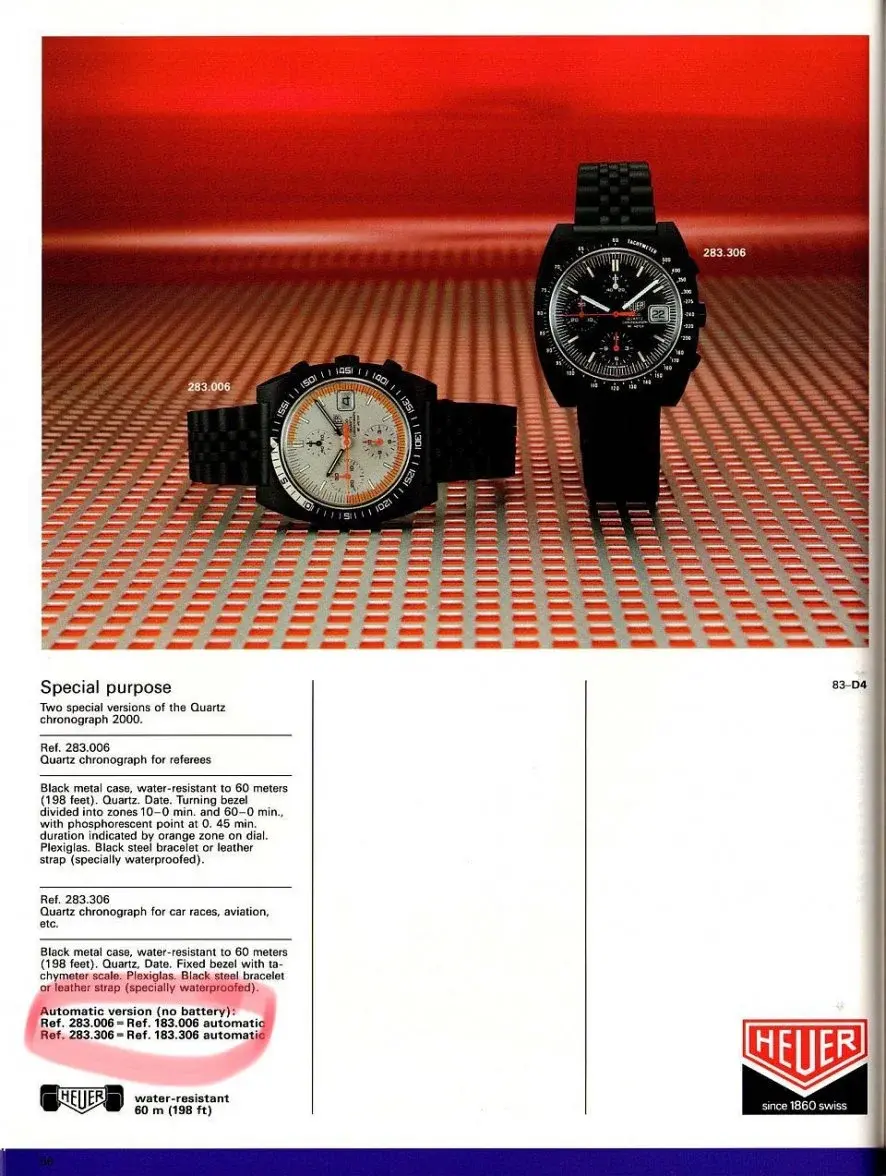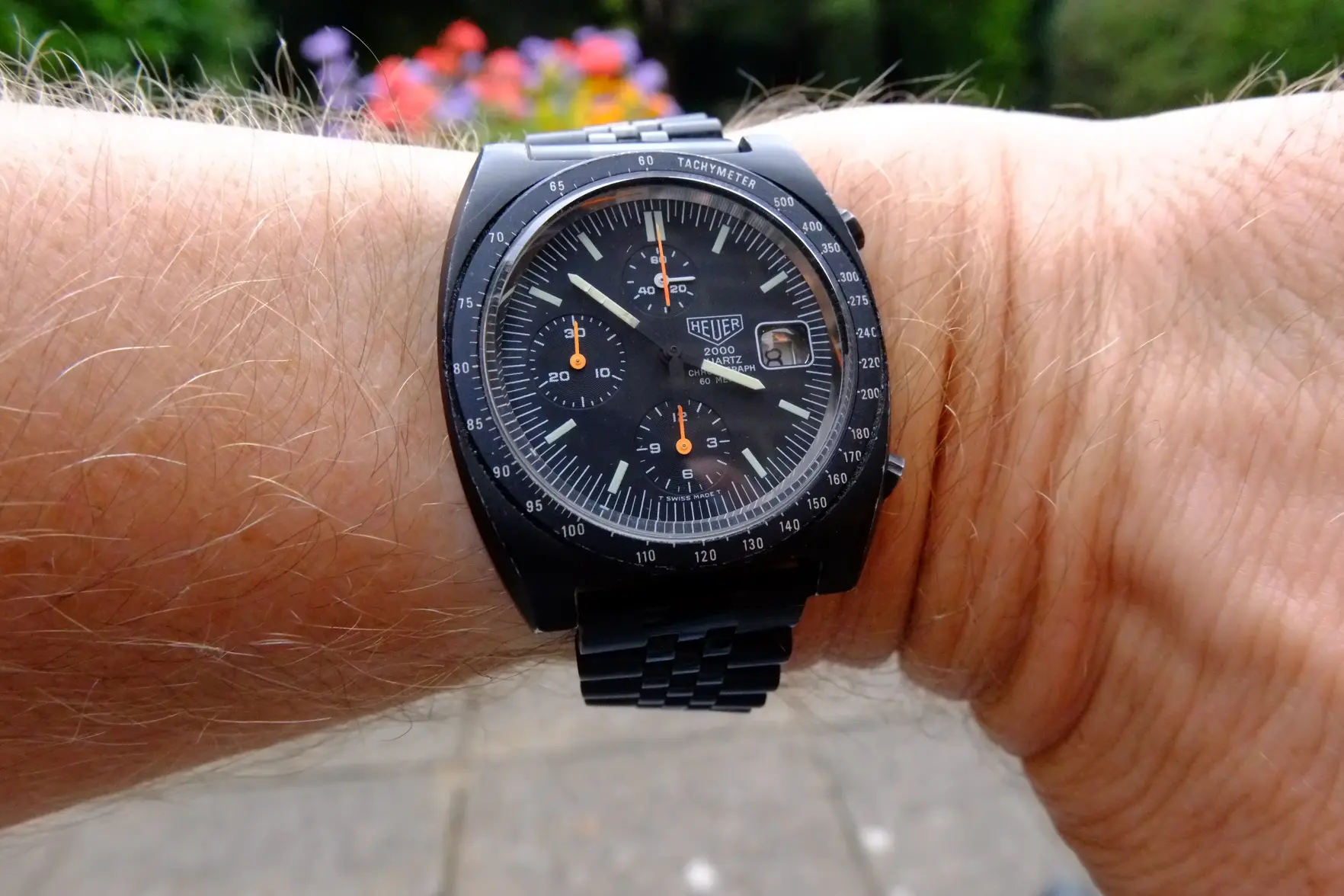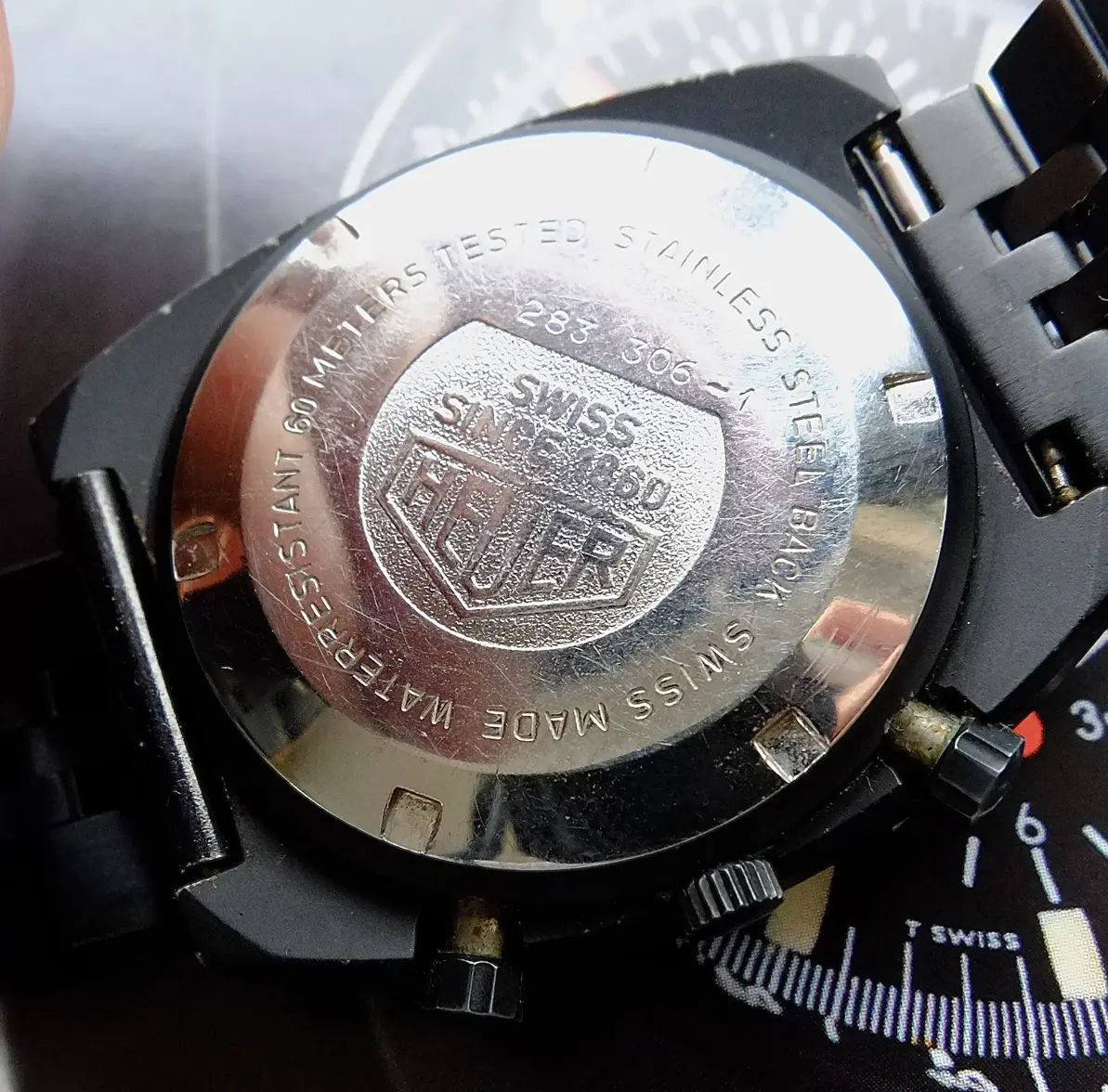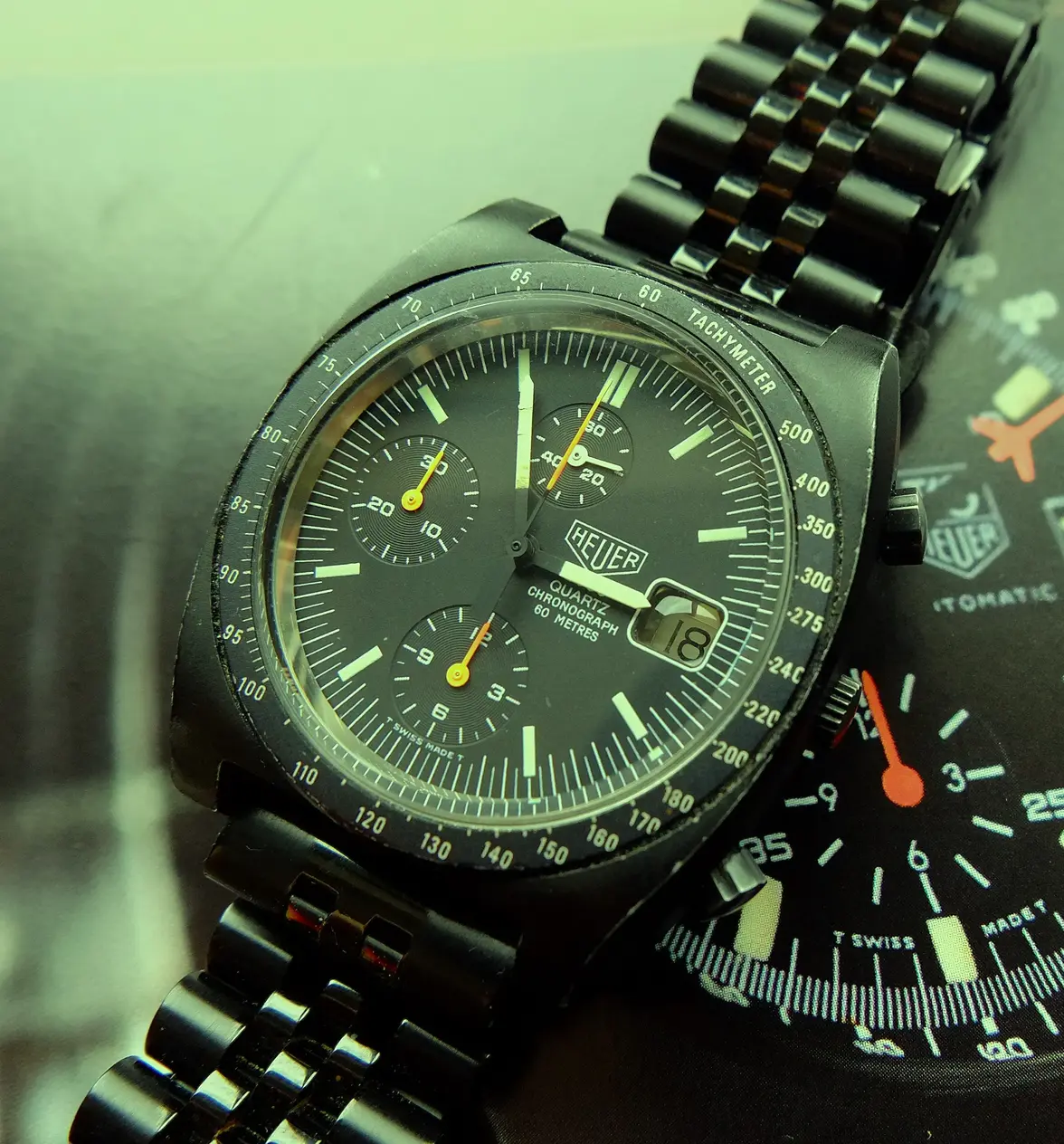Thehighwayman
·My first post on here and a long one at that !
I have something of an obsession with the odd couple of the early 2000 range,namely the 283.306,the associated 283.006 referee chronograph and their automatic variants.
There is very little info on these to be found and some of what is written is incorrect. I plan to put what I know about them in this post along with a bit of supposition for good measure !
Hopefully there may be a handful of these watches residing with other forum members and we can get a few photo's of them in the same place.
My first encounter with these scarce and interesting watches was I'm sure in late 1982,I had just left school and started as a trainee opposite a jewellers who retailed Heuer amongst other brands. I saw a 283.306 in the window and immediately fell in love with it. If memory serves me correctly it was around £250 GBP and I clearly remember the sales lady telling me they only had two,one auto and one quartz,both were the same price. I was on a trainee wage and there was no way on earth I could afford one,£250 was more than i'd just paid for a 5 year old Honda, my first motorcycle !
I suppose today it would be the equivalent of £800 GBP or thereabouts.
I looked at this watch in the window many times, waiting until my training was over with the full intention of buying it with my first decent wage packet.
It never happened of course, after a year or so it had gone for good.
I had always been interested in watches and never really forgot about this Heuer. Fast forward some 20 years and the vintage watch bug bit me hard,a few interesting flea market finds eventually led to me quitting my day job. I taught myself to repair and service watches and I became a small time vintage watch dealer.
The next 15 years or so were spent travelling the country buying from traders at watch fairs,usually in the car park before the fair began.. always the best deals 😁. I searched for stock at flea markets,antique fairs and occasionally bought the entire inventory from retired or deceased watchmakers estates. During this time I probably had 3 or 4 thousand watches through my hands, I had a few Heuer's,some of which I dearly wish I had kept but never once did I even get a sniff of a 283.306 or any of the variants.
I retired early some years ago but continue to collect vintage watches,deliberately buying them as non runners and repairing them at my leisure.I have a fairly sizeable collection including Zenith,Sinn,Tag, Omega,Oris and Longines amongst others.
I still wanted a 283.306 though,it really was my grail.
About 18 months ago I stumbled across one on the auction site we all love to hate.
A non runner with a cracked plexi at a less than generous buy it now price. It would have been a very good price for a runner but not for one with unknown issues,on the other hand it was cosmetically good and I was confident I could repair it. I thought about it for at least 30 seconds and jumped on it !😉
The first thing I did when it arrived was get a battery in there and put it on my quartz tester, it had a pulse but no discernible movement of the second hand whatsoever. Suspecting a blocked train I started to strip the quartz tractor movement and soon found a bit of debris jamming the wheels. I reassembled the movement and I had a runner with all chrono functions working well in less than an hour.. result !
Finding a suitable plexi was actually a bigger battle than the repair. I think I bought and tried six before I found the perfect replacement. It had to be a flat topped, armoured tension ring plexi with a bevelled edge and sufficient clearance for the hand stack. For reference, the ideal crystal for these is a 32mm Sternkreuz Dia C, but do use the original chrome tension ring in the new crystal as it is slightly deeper than the one supplied.
So, some 42 years after lusting after this watch I finally had one !
Immediately it became apparent that some of the things I had read about these were clearly wrong.
Firstly the case, I have seen these cases variously described as being stainless steel or painted brass. Heuer themselves wrongly described it as stainless steel in the 1983 catalogue,in 1984 they were more ambiguous and referred to it as "metal" .
The cases on these are in fact aluminium,unusual but not unique. As soon as you pick one up it's very apparent how light they are. They are actually lovely to wear,you forget you have it on your wrist. Historically aluminium cases are known for excessive wear around the spring bar holes but these cases seem to be a pretty hard grade and my watch shows no sign of excess wear at all.I would advise well fitting spring bars though,you don't want any movement that could make the holes oval over time.
Calibre 11 once wrote that these cases were Lemania era and used by other manufacturers,that is absolutely right. The cases were made by MRP SA and aside from the these Heuer's were used on a variety of Lemania 5012 powered chronographs. So far I have identified them branded as Arena,Lemania,Meylan and Rodania,more well known are the Sinn 143,a Porsche Design and the Philip Morris branded chrono for the McLaren F1 team. The case used on the Heuer differs only in the machining for the crown tube and pushers, the use of a modular movement meaning staggered stem and pusher height has to be accommodated.
It appears so far that the only non Lemania 5012 use of these cases was on these two Heuer models.
On to the movements in these watches, the automatic in the 183.306 and 183.006 is easy ,a Cal 283 and they remained the same through all the 2000 models.
The quartz however is a different matter.
Many assume that these watches all carry the Cal 185 and tick twice a second like the slightly later 2000's ... they don't !
In fact, my research suggests that most and probably all of these carry the short lived and universally forgotten Cal 183.
The Cal 183 arrived at the same time as it's automatic brother,and was probably initially produced in 1982. The Cal 183 used the same Dubois Depraz 2000 module but was mounted on a ESA 555.112 tractor with a standard once per second tick. The Cal 183 was shortlived,probably a year or less before it became the upgraded Cal 185.
The Cal 185 addressed a number of perceived or real issues.
The main modification was to use the ESA 555.232 as the tractor unit.this was a modified movement with a circuit and rotor designed to tick twice a second for the purposes of increasing the available torque.The train wheels were also changed with a doubling of the number of teeth and some modifications were made to the top plate to ease removal of the module. The only obvious reason to increase torque on the tractor movement would be that the standard ESA 555.112 was felt to be at the outer limit of it's capability in driving the chrono module. It's well known that a quartz movement puts out a fraction of the power compared to an an auto like the ETA 2892 in the Cal 283.Whether real problems had arisen in use or were simply feared we'll never know but it was obviously felt to be marginal.
It's pretty easy to tell whether these watches have a Cal 183 or a 185 and so far I have yet to see a photo of one of these watches with a 185 which suggests they were perhaps the first pieces built with the new modular movements. The Cal 185's have a small metal plate engraved " Cal 185", the 183's show no caliber number but have a small gilt plate engraved Swiss Made, Twenty Five Jewels, Unadjusted - as shown on my watch above. In addition, the inside of the caseback on the quartz versions is stamped "183" the autos are stamped "283" as you would expect.
Today a Cal 183 has a distinct advantage over the 185 in terms of parts supply,circuits are easy to source unlike the 185 where they are to all intents unobtainable. It should however be relatively easy to "backdate" a 185 and turn it into a 183 by changing both the circuit and rotor . This is no help if you have a dodgy DD chrono module of course but even those can be serviced.
Referring back to Calibre 11 again,he described these watches as cool but not a 2000 and a throwback to the Lemania era. I agree entirely and have my own pet theory. My feeling is that these watches were designed some time before the rest of the 2000 range,Lemania,Heuer and Dubois Depraz had been working on this movement since the late 70's.I suspect cases and dials were sourced and stocked but for whatever reason production was delayed or held back,perhaps due to delays with the new movements. Once production was able to commence the goalposts had moved and the game had changed. Eddie Schopfer had designed an entirely different range identity for the 2000's and these watches were left like the awkward siblings with nowhere to sit comfortably. Heuer themselves by tagging these watches on the end of the 2000 range and describing them as "special versions" were really tacitly admitting they were outliers.
Aesthetically they are much more akin to the PVD 5100 powered Carrera and really shared nothing in design terms with the new 2000 range.
Finally I'll move on to the variations I have spotted on these watches.
You can see in the catalogue scan that the 283.306 is shown with an all red centre chrono seconds hand. I have yet to see a production version with this all red hand .All 283.306's I have viewed have the tail of the hand in matt black,however the black paint on some stops at the centre boss and on others it continues considerably further up the hand.
The referee version though can be found with an all red second hand but some do have the matt black tail section,however I am yet to see one where the matt black paint continues beyond the centre boss.
In terms of hand colours the vast majority are red with varying degrees of fading. My watch however has very bright and highly fluorescent orange hands,bordering on yellow in fact. I am certain these are original and I don't believe they have faded in that way so i'm going to count it as a variation! 😉
In summary i love these watches, technically interesting both in terms of the movement and case material and they are a "proper Heuer" with a classic highly legible and cohesive design. They also have a bit of mystery about them with questions about their existence in the range.
They are scarce to the point of being genuinely rare, I look for them regularly and have seen perhaps half a dozen for sale worldwide across all variants in the last 18 months.
I suspect few were made,probably only the initial run and then they quietly disappeared. I have seen one for sale with a stamped guarantee card dated for late 1987 which suggests they weren't a big seller and at least some sat in dealers for a long time.
When I first got mine I sent my son a photo, his immediate response was "That's a brute and super cool with it" ... I concur !
I have something of an obsession with the odd couple of the early 2000 range,namely the 283.306,the associated 283.006 referee chronograph and their automatic variants.
There is very little info on these to be found and some of what is written is incorrect. I plan to put what I know about them in this post along with a bit of supposition for good measure !
Hopefully there may be a handful of these watches residing with other forum members and we can get a few photo's of them in the same place.
My first encounter with these scarce and interesting watches was I'm sure in late 1982,I had just left school and started as a trainee opposite a jewellers who retailed Heuer amongst other brands. I saw a 283.306 in the window and immediately fell in love with it. If memory serves me correctly it was around £250 GBP and I clearly remember the sales lady telling me they only had two,one auto and one quartz,both were the same price. I was on a trainee wage and there was no way on earth I could afford one,£250 was more than i'd just paid for a 5 year old Honda, my first motorcycle !
I suppose today it would be the equivalent of £800 GBP or thereabouts.
I looked at this watch in the window many times, waiting until my training was over with the full intention of buying it with my first decent wage packet.
It never happened of course, after a year or so it had gone for good.
I had always been interested in watches and never really forgot about this Heuer. Fast forward some 20 years and the vintage watch bug bit me hard,a few interesting flea market finds eventually led to me quitting my day job. I taught myself to repair and service watches and I became a small time vintage watch dealer.
The next 15 years or so were spent travelling the country buying from traders at watch fairs,usually in the car park before the fair began.. always the best deals 😁. I searched for stock at flea markets,antique fairs and occasionally bought the entire inventory from retired or deceased watchmakers estates. During this time I probably had 3 or 4 thousand watches through my hands, I had a few Heuer's,some of which I dearly wish I had kept but never once did I even get a sniff of a 283.306 or any of the variants.
I retired early some years ago but continue to collect vintage watches,deliberately buying them as non runners and repairing them at my leisure.I have a fairly sizeable collection including Zenith,Sinn,Tag, Omega,Oris and Longines amongst others.
I still wanted a 283.306 though,it really was my grail.
About 18 months ago I stumbled across one on the auction site we all love to hate.
A non runner with a cracked plexi at a less than generous buy it now price. It would have been a very good price for a runner but not for one with unknown issues,on the other hand it was cosmetically good and I was confident I could repair it. I thought about it for at least 30 seconds and jumped on it !😉
The first thing I did when it arrived was get a battery in there and put it on my quartz tester, it had a pulse but no discernible movement of the second hand whatsoever. Suspecting a blocked train I started to strip the quartz tractor movement and soon found a bit of debris jamming the wheels. I reassembled the movement and I had a runner with all chrono functions working well in less than an hour.. result !
Finding a suitable plexi was actually a bigger battle than the repair. I think I bought and tried six before I found the perfect replacement. It had to be a flat topped, armoured tension ring plexi with a bevelled edge and sufficient clearance for the hand stack. For reference, the ideal crystal for these is a 32mm Sternkreuz Dia C, but do use the original chrome tension ring in the new crystal as it is slightly deeper than the one supplied.
So, some 42 years after lusting after this watch I finally had one !
Immediately it became apparent that some of the things I had read about these were clearly wrong.
Firstly the case, I have seen these cases variously described as being stainless steel or painted brass. Heuer themselves wrongly described it as stainless steel in the 1983 catalogue,in 1984 they were more ambiguous and referred to it as "metal" .
The cases on these are in fact aluminium,unusual but not unique. As soon as you pick one up it's very apparent how light they are. They are actually lovely to wear,you forget you have it on your wrist. Historically aluminium cases are known for excessive wear around the spring bar holes but these cases seem to be a pretty hard grade and my watch shows no sign of excess wear at all.I would advise well fitting spring bars though,you don't want any movement that could make the holes oval over time.
Calibre 11 once wrote that these cases were Lemania era and used by other manufacturers,that is absolutely right. The cases were made by MRP SA and aside from the these Heuer's were used on a variety of Lemania 5012 powered chronographs. So far I have identified them branded as Arena,Lemania,Meylan and Rodania,more well known are the Sinn 143,a Porsche Design and the Philip Morris branded chrono for the McLaren F1 team. The case used on the Heuer differs only in the machining for the crown tube and pushers, the use of a modular movement meaning staggered stem and pusher height has to be accommodated.
It appears so far that the only non Lemania 5012 use of these cases was on these two Heuer models.
On to the movements in these watches, the automatic in the 183.306 and 183.006 is easy ,a Cal 283 and they remained the same through all the 2000 models.
The quartz however is a different matter.
Many assume that these watches all carry the Cal 185 and tick twice a second like the slightly later 2000's ... they don't !
In fact, my research suggests that most and probably all of these carry the short lived and universally forgotten Cal 183.
The Cal 183 arrived at the same time as it's automatic brother,and was probably initially produced in 1982. The Cal 183 used the same Dubois Depraz 2000 module but was mounted on a ESA 555.112 tractor with a standard once per second tick. The Cal 183 was shortlived,probably a year or less before it became the upgraded Cal 185.
The Cal 185 addressed a number of perceived or real issues.
The main modification was to use the ESA 555.232 as the tractor unit.this was a modified movement with a circuit and rotor designed to tick twice a second for the purposes of increasing the available torque.The train wheels were also changed with a doubling of the number of teeth and some modifications were made to the top plate to ease removal of the module. The only obvious reason to increase torque on the tractor movement would be that the standard ESA 555.112 was felt to be at the outer limit of it's capability in driving the chrono module. It's well known that a quartz movement puts out a fraction of the power compared to an an auto like the ETA 2892 in the Cal 283.Whether real problems had arisen in use or were simply feared we'll never know but it was obviously felt to be marginal.
It's pretty easy to tell whether these watches have a Cal 183 or a 185 and so far I have yet to see a photo of one of these watches with a 185 which suggests they were perhaps the first pieces built with the new modular movements. The Cal 185's have a small metal plate engraved " Cal 185", the 183's show no caliber number but have a small gilt plate engraved Swiss Made, Twenty Five Jewels, Unadjusted - as shown on my watch above. In addition, the inside of the caseback on the quartz versions is stamped "183" the autos are stamped "283" as you would expect.
Today a Cal 183 has a distinct advantage over the 185 in terms of parts supply,circuits are easy to source unlike the 185 where they are to all intents unobtainable. It should however be relatively easy to "backdate" a 185 and turn it into a 183 by changing both the circuit and rotor . This is no help if you have a dodgy DD chrono module of course but even those can be serviced.
Referring back to Calibre 11 again,he described these watches as cool but not a 2000 and a throwback to the Lemania era. I agree entirely and have my own pet theory. My feeling is that these watches were designed some time before the rest of the 2000 range,Lemania,Heuer and Dubois Depraz had been working on this movement since the late 70's.I suspect cases and dials were sourced and stocked but for whatever reason production was delayed or held back,perhaps due to delays with the new movements. Once production was able to commence the goalposts had moved and the game had changed. Eddie Schopfer had designed an entirely different range identity for the 2000's and these watches were left like the awkward siblings with nowhere to sit comfortably. Heuer themselves by tagging these watches on the end of the 2000 range and describing them as "special versions" were really tacitly admitting they were outliers.
Aesthetically they are much more akin to the PVD 5100 powered Carrera and really shared nothing in design terms with the new 2000 range.
Finally I'll move on to the variations I have spotted on these watches.
You can see in the catalogue scan that the 283.306 is shown with an all red centre chrono seconds hand. I have yet to see a production version with this all red hand .All 283.306's I have viewed have the tail of the hand in matt black,however the black paint on some stops at the centre boss and on others it continues considerably further up the hand.
The referee version though can be found with an all red second hand but some do have the matt black tail section,however I am yet to see one where the matt black paint continues beyond the centre boss.
In terms of hand colours the vast majority are red with varying degrees of fading. My watch however has very bright and highly fluorescent orange hands,bordering on yellow in fact. I am certain these are original and I don't believe they have faded in that way so i'm going to count it as a variation! 😉
In summary i love these watches, technically interesting both in terms of the movement and case material and they are a "proper Heuer" with a classic highly legible and cohesive design. They also have a bit of mystery about them with questions about their existence in the range.
They are scarce to the point of being genuinely rare, I look for them regularly and have seen perhaps half a dozen for sale worldwide across all variants in the last 18 months.
I suspect few were made,probably only the initial run and then they quietly disappeared. I have seen one for sale with a stamped guarantee card dated for late 1987 which suggests they weren't a big seller and at least some sat in dealers for a long time.
When I first got mine I sent my son a photo, his immediate response was "That's a brute and super cool with it" ... I concur !






